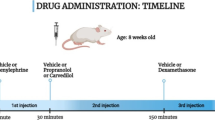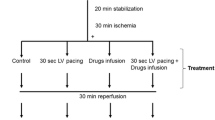Summary
Dexamethasone (6 mg/kg) given intravenously to anesthetized cats exerted no significant hemodynamic effect on control open-chest cats or in cats subjected to acute myocardial ischemia by coronary artery ligature. However, dexamethasone normalized elevated S-T segments toward preischemic values, and prevented much of the increase in plasma CPK activity following coronary artery ligation. Moreover, dexamethasone prevented loss of CK activity within ischemic myocardial tissue five hours after the onset of ischemia. Dexamethasone also reduced the extent of ischemic damage as assessed by a nitro-blue tetrazolium staining technique, providing anatomic verification of the reduced ischemic damage. Moreover, dexamethasone prevented the swelling and vacuolization of myocardial lysosomes in the ischemic region, indicating a stabilization of lysosomal membranes within the heart. These data indicate that lysosomal disruption is an important consequence of myocardial ischemia and that early treatment with dexamethasone prevents the loss of myocardial lysosomal and cellular enzymes as reflected in normalization of the ECG and plasma CK activity of ischemic cats. In this way, dexamethasone may act to retard the spread of the developing infarct within the ischemic myocardium.
Zusammenfassung
Intravenöse Verabfolgung von Dexamethason (6 mg/kg) hatte keine signifikanten hämodynamischen Effekte, weder bei Kontrollkatzen mit offenem Thorax noch bei Katzen mit akuter myokardialer Ischämie infolge Koronararterienligatur. Jedoch machte Dexamethason eine ischämisch bedingte ST-Hebung rückgängig und wirkte in starkem Maße vorbeugend gegenüber dem Anstieg der Plasma-CPK-Aktivität nach Koronararterienunterbindung. Darüber hinaus verhinderte Dexamethason 5 Stunden nach dem Einsetzen der Ischämie den Verlust der CK-Aktivität im ischämischen Myokardgewebe. Auch reduzierte Dexamethason das Ausmaß der ischämischen Schädigung bei Bewertung auf der Grundlage der Nitroblau-Tetrazolium-Technik. Darüber hinaus verhinderte Dexamethason die Schwellung und Vakuolisierung myokardialer Lysome in der ischämischen Region als Hinweis auf eine Stabilisierung lysosomaler Membranen im Herzen. Diese Ergebnisse zeigen, daß die strukturelle Zerstörung der Lysosomen eine wichtige Konsequenz der myokardialen Ischämie darstellt und daß eine frühe Behandlung mit Dexamethason den Verlust von lysosomalen und zellulären Enzymen des Myokards verhindert, was in einer Normalisierung des Ekg und der Plasma-Aktivität der ischämischen Katzen zum Ausdruck kommt. Auf diese Art und Weise dürfte Dexamethason einer Ausbreitung der Infarzierung im ischämischen Myokard entgegenwirken.
Similar content being viewed by others
References
Libby, P., P. R. Maroko, C. M. Bloor, B. E. Sobel, E. Braunwald: Reduction of experimental myocardial infarct size by corticosteroid adminsstration. J. Clin. Invest.52, 599 (1973).
Busuttil, R. W., W. J. George, R. L. Hewitt: Protective effect of methylprednisolone on the heart during ischemic arrest. J. Thorac. Cardiovasc. Surg.70, 955 (1975).
Spath, J. A., Jr., D. L. Lane, A. M. Lefer: Protective action of methylprednisolone on the myocardium during experimental myocardial ischemia in the cat. Circulat. Res.35, 44 (1974).
Morrison, J., T. Maley, L. Reduto, C. Victa, L. Brandon, C. Gulotta: Effect of methylprednisolone on predicted myocardial infarction size in man. Crit. Care Med.3, 94 (1975).
Peters, R. W., A. Norman, W. W. Parmley, B. B. Emilson, M. M. Scheinman, M. Cheitlin: Effect of therapy with methylprednisolone on the size of myocardial infarcts in man. Chest73, 483 (1978).
Vogel, W. M., V. G. Zannoni, G. D. Abrams, B. R. Lucchesi: Inability of methylprednisolone sodium succinate to decrease infarct size or preserve enzyme activity measured 24 hours after coronary occlusion in the dog. Circulation55, 588 (1977).
Roberts, R., V. DeMello, B. E. Sobel: Deleterious effects of methylprednisolone in patients with myocardial infarction. Circulation53, 204 (1976).
Shatney, C. H., D. J. MacCarter, R. C. Lillehei: Temporal factors in the reduction of myocardial infarct volume by methylprednisolone. Surgery80, 61 (1976).
Rosalki, S. B.: An improved procedure for creatine phosphokinase determination. J. Lab. Clin. Med.69, 696 (1967).
Kjekshus, J. K., B. E. Sobel: Depressed myocardial creatine phosphokinase activity following experimental myocardial infarction in rabbit. Circulat. Res.27, 403 (1970).
Anson, M. L.: The estimation of cathepsin with hemoglobin and the partial purification of cathepsin. J. Gen. Physiol.20, 565 (1936).
Gornall, A. G., C. J. Bardowill, M. M. David: Determination of serum proteins by means of the biuret reaction. J. Biol. Chem.177, 751 (1949).
Nachlas, M. M., T. K. Schnitka: Macroscopic identification of early myocardial infarcts by alterations in dehydrogenase activity. Amer. J. Path.42, 379 (1963).
Miller, F., G. Palade: Lytic activities in renal protein absorption droplets: an electron microscopical cytochemical study. J. Cell Biol.23, 519 (1964).
Spurr, A. R.: A low-viscosity epoxy resin embedding medium for electron microscopy. J. Ultrastruct. Res.26, 31 (1969).
Ogletree, M. J., J. B. Smith, A. M. Lefer: Actions of prostaglandins on isolated perfused cat coronary arteries. Amer. J. Physiol.235, H400 (1978).
Lefer, A. M.: Pathophysiology of acute myocardial infarction. In: Cardiovascular Clinics. Edited by:A. N. Brest, pp. 25 (Philadelphia 1975).
Decker, R. S., K. Wildenthal: Influence of methylprednisolone on ultrastructural and cytochemical changes during myocardial ischemia. Amer. J. Path.92, 1 (1978).
Morrison, J., L. Reduto, R. Pizzarello, K. Geller, T. Maley, S. Gulotta: Modification of myocardial injury in man by corticosteroid administration. Circulation53, 200 (1976).
Beardsley, A. C., M. Okuda, A. M. Lefer: Absence of a cardiodynamic action of glucocorticoids in acute myocardial ischemia. J. Surg. Res.20, 17 (1976).
Spath, J. A., Jr., R. J. Gorczynski, A. M. Lefer: Possible mechanisms of the beneficial action of glucocorticoids in circulatory shock. Surg. Gynecol. Obstet.137, 597 (1973).
Kadowitz, P. J., A. C. Yard: Circulatory effects of hydrocortisone and protection against endotoxin shock in cats. Eur. J. Pharmacol.9, 311 (1970).
Weissmann, G.: Effects of steroids and drugs on lysosomes; in:Dingle andFell, Lysosomes in biology and pathology, Part I, pp. 276 (New York 1969).
Lefer, A. M., J. L. Martin: Mechanism of the protective effect of corticosteroids in hemorrhagic shock. Amer. J. Physiol.216, 314 (1969).
Okuda, M., K. R. Young, Jr., A. M. Lefer: Localization of glucocorticoid uptake in normal and ischemic myocardial tissue of isolated perfused cat hearts. Circulat. Res.39, 640 (1976).
Beardsley, A. C., M. Okuda, A. M. Lefer: Factors influencing non-specific binding of glucocorticoids in myocardial tissue. Proc. Soc. Exptl. Biol. Med.151, 457 (1976).
Ferguson, W. W., T. M. Glenn, A. M. Lefer: Mechanisms of production of circulatory shock factors in isolated perfused pancreas. Amer. J. Physiol.222, 450 (1972).
Galvin, M. J., K. Shupe, A. M. Lefer: Anti-endotoxin actions of methylprednisolone in isolated perfused cat liver. Pharmacology17, 181 (1978).
Author information
Authors and Affiliations
Additional information
With 6 figures and 1 table
Supported in part by grants from the W. W. Smith Foundation and by Organon, Inc.
Summer Research Fellow of the Ischemia-Shock Research Center
Rights and permissions
About this article
Cite this article
Lefer, A.M., Crossley, K., Grigonis, G. et al. Mechanism of the beneficial effect of dexamethasone on myocardial cell integrity in acute myocardial ischemia. Basic Res Cardiol 75, 328–339 (1980). https://doi.org/10.1007/BF01907581
Received:
Issue Date:
DOI: https://doi.org/10.1007/BF01907581




